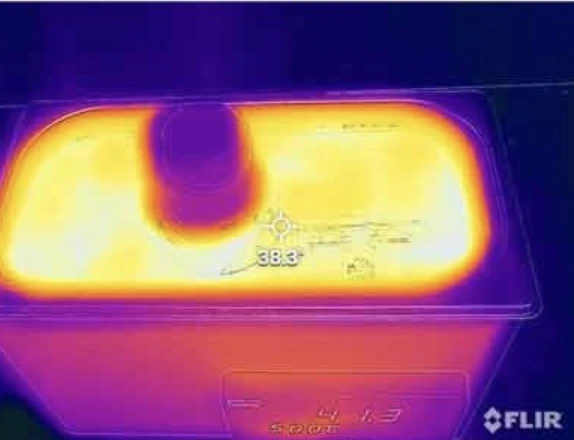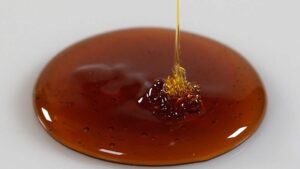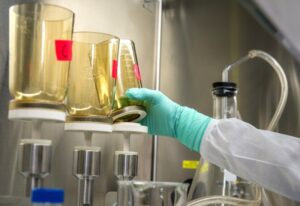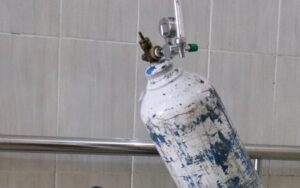This quick reference guide provides information on choosing the best type of water bath equipment for your application, basic operating instructions and safety.
- Fastest heat up time @ 15-25min: Circulating water bath
- Minimum viable setup: Water Bath
- Overnight heating / low maintenance: “Bead” water bath
Definitions
- Circulating Water Bath – circulating bath with active water movement & thermal control
- Standard Water Bath – using water as heat transfer medium
- “Bead” Water Bath – using metal or glass beads as heat transfer medium
Safety Precautions for Water Bath Equipment
- ⛔️ Always treat fluids as though they may be hot enough for burn risk. ⛔️
- Frayed or damaged cords – never operate lab equipment with cord damage.
- Never submerge hands, contaminated (dirty or used) tools. Burn risks may occur.
- Never exceed the fluid’s flash point.
- Never use a fluid with a pH level high enough to corrode the bath metal.
Determining Which Type of Water Bath Equipment to Use
Cold Storage Product Reheating
- Circulating bath (recommended) ~15-25min retherm time
- Standard Water Bath ~ 25-40 min retherm time
- “Bead” Water Bath ~ 1hr minimum retherm time
Ambient Product Reheating
- Standard Water Bath (recommended) ~ 20-30 min retherm time
- Overnight Temperature Hold / Long Term Heat Hold
- “Bead” Water Bath (recommended)~ 40min retherm time
Circulating Bath Instructions
Circulating baths are for fast heat up of material and media due to active water movement for fast heat transfer.
Powering On
-
- Be sure an adequate fluid level is in the reservoir.
1.1 Consult manual for minimum fluid level required, generally 2 inches or more for proper thermometer and circulator pump engagement.
-
- Set to desired temperature, generally found in instructions or lab practice guides.
2.1 Set the desired temperature, 45°C to 55°C, safe temperatures for distillate media.
Compatible Fluids
-
- Distilled water – used to avoid corrosion, buildup, and contaminates. Do not use other liquids.
- Be sure to empty and clean the unit if reservoir fluid is mixed, changed, or contaminated.
- Fluid may evaporate, monitor fluid level and refill safely as needed.
3.1 The lid may be placed on the unit to minimize evaporation.
Filling and Draining
- Never drain hot fluids, allow to cool before draining.
- Always drain liquid from the reservoir before moving the unit. Ex. Do not try to “scoot” the unit aside to make room for a box.
Water Bath Instructions
Water baths are fast and uncomplicated devices for heating materials and media. While not as fast as circulating units there are no moving parts and can heat multiple jars at the same time.
Powering On
-
- Be sure an adequate fluid level is in the reservoir.
1.1 Consult manual for minimum fluid level required, generally 2 inches or more for proper thermometer engagement.
-
- ⛔️Water bath heaters are under the tank – these jars and media usually require a spacer for baths to function. ⛔️
- Set to desired temperature, generally found in instructions or lab practice guides.
3.1 Set the desired temperature, 45°C to 55°C, safe temperatures for distillate media.
Compatible Fluids
-
- Distilled water – used to avoid corrosion, buildup, and contaminates. Do not use other liquids.
- Be sure to empty and clean the unit if reservoir fluid is mixed, changed, or contaminated.
- Fluid may evaporate, monitor fluid level and refill safely as needed.
3.1 The lid may be placed on the unit to minimize evaporation.
Filling and Draining
- Never drain hot fluids, allow to cool before draining.
- Always drain liquid from the reservoir before moving the unit. Ex. Do not try to “scoot” the unit aside to make room for a box.
“Bead” Water Bath Instructions
Bead baths can heat and hold temperature overnight for long periods of time without the need to refill water. While being 2-3X slower as a heating method, operators can cover the container with beads to heat even top portions of the container to lower transfer loss.
Powering On
-
- Insert container and cover container up to the cap with beads.
1.1 Using large metal beads may also require a cover due to air convection from gaps in the beads.
-
- Set to desired temperature, generally found in instructions or lab practice guides.
2.1 Set the desired temperature, 45°C to 55°C, safe temperatures for distillate media.
Filling and Draining
- ⛔️Beads have higher heat capacity than water – the beads in the center of the bath retain temperature for a long time and can cause burns. ⛔️




